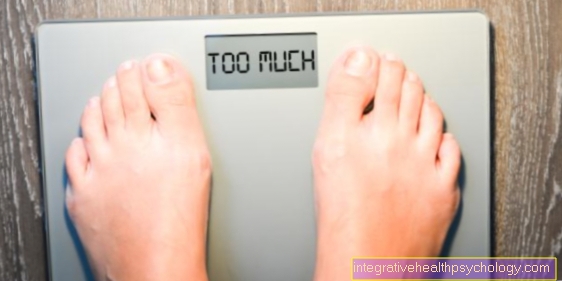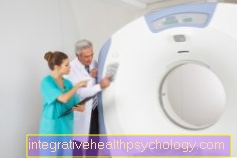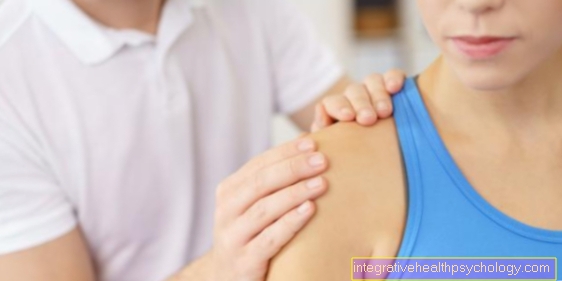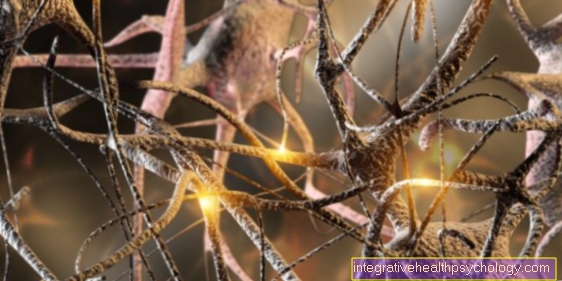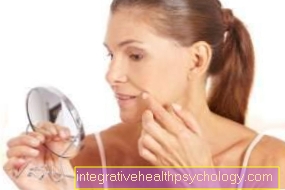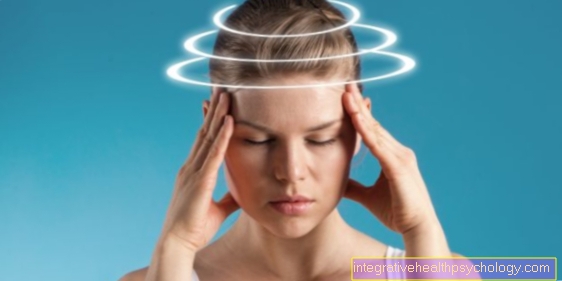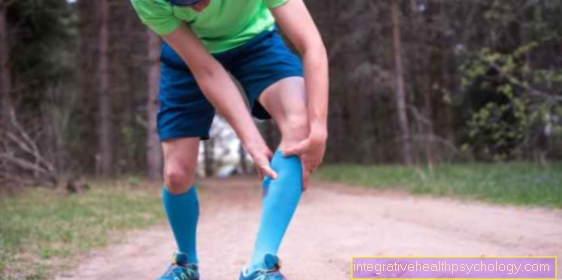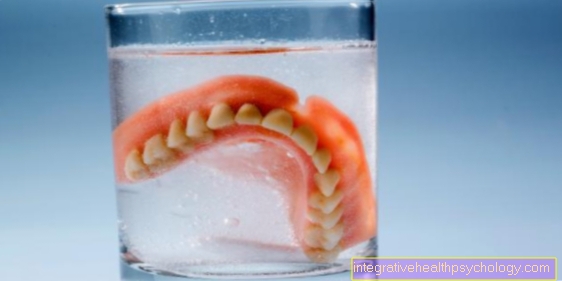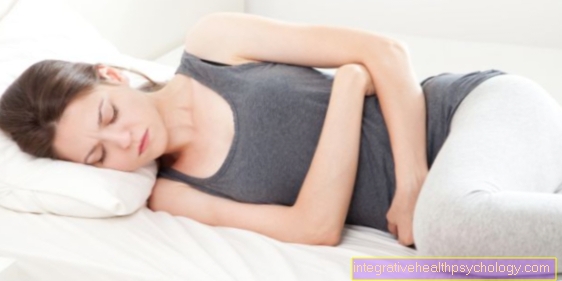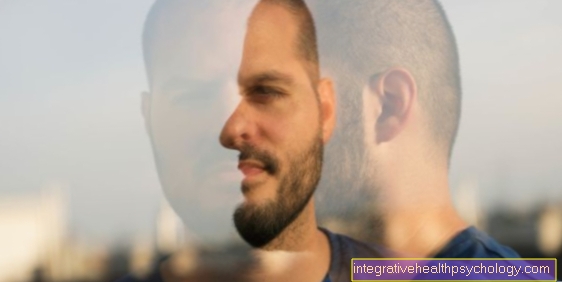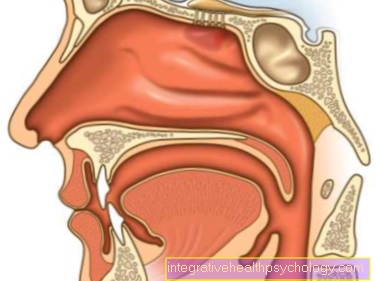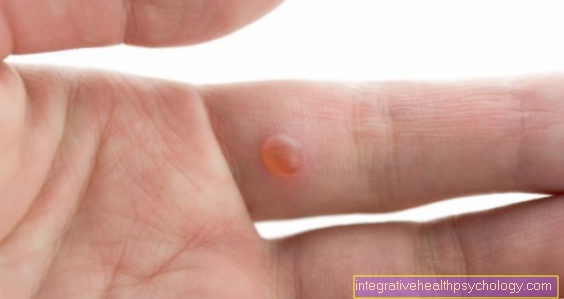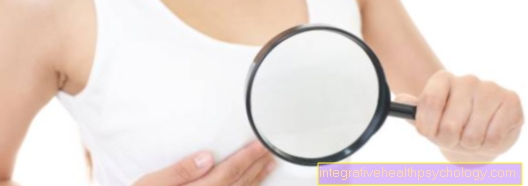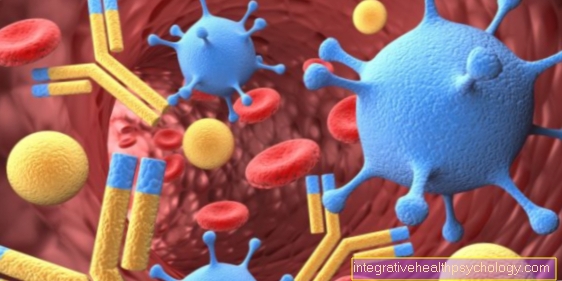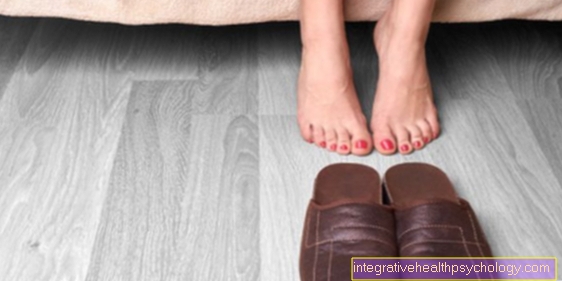KiSS syndrome
definition
The KiSS syndrome is a misalignment in the area of the upper cervical spine and the head joint, which occurs in small children and can persist into adulthood. This misalignment leads to a visible malposition, which has led to the synonym torticollis. It is also seen as the trigger for various behavioral disorders. The diagnosis of KiSS syndrome is not recognized by conventional medicine due to a lack of evidence for the existence of the syndrome. Likewise, the statutory health insurance does not recognize the KiSS syndrome, so that the costs for a therapy have to be paid privately.
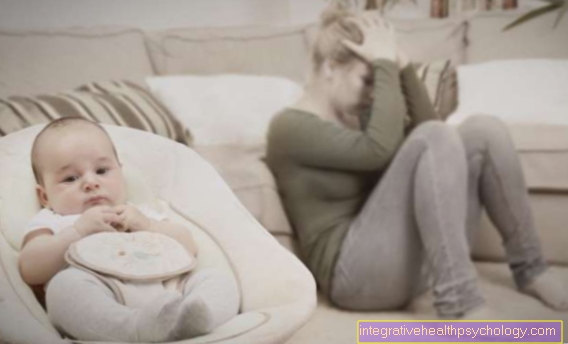
Symptoms
Typically, children with the KiSS syndrome fall into infancy as so-called "Cry babies" on. In conventional medicine one often speaks of three-month colic, in alternative medicine this phenomenon is attributed to the traumatic event of the child's birth.
Other typical signs of a KiSS syndrome are the one-sided positioning of the head with the result that the back of the head is flattened and the child is looking in a preferred direction. Difficulties in breastfeeding are also assessed as an effect of poor posture. In the growing child, developmental and behavioral disorders are typical symptoms. Children who often slip on their bums and skip the crawling phase are rated as additional signs of undesirable developments.
For more information, see our article on the subject Breastfeeding
Appointment with a back specialist?

I would be happy to advise you!
Who am I?
My name is dr. Nicolas Gumpert. I am a specialist in orthopedics and the founder of .
Various television programs and print media report regularly about my work. On HR television you can see me every 6 weeks live on "Hallo Hessen".
But now enough is indicated ;-)
The spine is difficult to treat. On the one hand it is exposed to high mechanical loads, on the other hand it has great mobility.
The treatment of the spine (e.g. herniated disc, facet syndrome, foramen stenosis, etc.) therefore requires a lot of experience.
I focus on a wide variety of diseases of the spine.
The aim of any treatment is treatment without surgery.
Which therapy achieves the best results in the long term can only be determined after looking at all of the information (Examination, X-ray, ultrasound, MRI, etc.) be assessed.
You can find me in:
- Lumedis - your orthopedic surgeon
Kaiserstrasse 14
60311 Frankfurt am Main
Directly to the online appointment arrangement
Unfortunately, it is currently only possible to make an appointment with private health insurers. I hope for your understanding!
Further information about myself can be found at Dr. Nicolas Gumpert
Symptom "screaming child"
A symptom that occurs very frequently in the context of a KiSS disease and in many cases is also the reason for most medical consultations with this suspicion is embodied by children who constantly scream and simply cannot be calmed down.
Most parents are completely insecure and simply cannot explain why their young children cry all the time, cannot sleep, often refuse to eat and simply cannot be calmed down. Due to the varying degrees of postural disorders that can occur as part of a KiSS disease, the children often experience severe pain and restricted mobility. These painful restrictions on mobility make it difficult to drink from the maternal breast and thus lead to reduced food intake. The affected children express their pain and discomfort by screaming vigorously, are very restless and simply cannot be calmed down. The screaming is often very painful and sometimes slight painful movements or changes in the lying position can make it even worse.
Parents seek advice at the pediatrician because they have one "Screaming child" If you have a three-month colic, you should always keep the presence of a KiSS syndrome in mind and look for other symptoms.
Learn more about: Help in dealing with a cry baby
causes
The cause of the KiSS syndrome is considered to be the increased stress on the head joints before birth or during childbirth. Already in the uterus, a head-end position or a multiple pregnancy can lead to incorrect stress on the head joints. During childbirth, prolonged labor can exert recurrent pressure on the child, pressing against the birth canal. Even normal hyperextension of the head when passing through the birth canal can damage the head joints. The occurrence is seen more often with the use of obstetric aids such as forceps or the suction cup, both of which exert a tremendous amount of tension on the area of the upper cervical spine.
What is the difference between a KiSS-1 and a KiSS-2 syndrome?
In today's medicine, the clinical picture of the KiSS syndrome is divided into two different forms.
In KiSS-1 syndrome, the head joint and cervical vertebrae are so twisted and blocked that turning and tilting the head to the side is painful for the child. In order to avoid this, the children adopt a gentle posture, which can lead to one-sided asymmetrical deformities such as a torticollis, C-scoliosis, a flattened back of the head or a reduced mobility of the affected half of the body.
In the KiSS-2 syndrome, the head joint and the cervical vertebrae are also twisted and blocked. However, the child overstretched their head backwards to avoid the pain. The so-called KiSS stain typically occurs here. This is a round hair section and a flattened back of the head. The children refuse to lie prone and show significant developmental disorders. The overstretched head position can narrow the child's windpipe when screaming, which can lead to a life-threatening lack of oxygen. KiSS-2 children are even more often among the screaming children, as it is difficult for them to find a suitable lying position that does not cause them pain.
How can you recognize a KiSS syndrome yourself?
Recognizing kiss syndrome yourself is not that easy, as it can be associated with many different symptoms, all of which are also very unspecific. However, there are a number of symptoms that can indicate the presence of a head joint - induced - symmetry disorder. Since the disease is a misalignment of the first two cervical vertebrae, the children are particularly noticeable due to an incorrect posture of the head or trunk in a certain direction.
Often you can also see an overstretching of the entire body. The children often have a lopsided position in their cot and have considerable problems turning their heads, as well as a pronounced weakness in holding. In some cases, the parents also notice an asymmetry of the face and a misalignment of the extremities.
In order to become aware of the possible existence of a KiSS syndrome, it is particularly important to pay attention to possible changes in the children's behavior. Affected children lapse into long-lasting, excruciating screams, especially when picked up. They often suffer from insomnia and individual stages are left out of development. In addition, most children suffer from a limited field of vision due to the weakness of the head. A delay in development caused by difficult food intake due to drinking difficulties with an inclined head can also be observed in many cases and can be a first indication of the presence of a KiSS syndrome.
consequences
Depending on the age, the KiSS syndrome is held responsible for the development of various physical and psychological disorders.
Consequences of the KiSS syndrome in infants
The KiSS syndrome results in a developmental disorder in infants, which is noticeable both in slowed motor development and later in language development. Often there are also sleep disorders with long nocturnal awakenings, hip maturation disorders and asymmetries in the head and face area. Also possible is a lack of mouth closure, which is made partly responsible for difficulties in breastfeeding and a generally weak drinking behavior with the risk of insufficient supply.
Consequences of the KiSS syndrome in young children
In this age group, behavioral problems are in the foreground, which are increasingly noticeable in kindergarten and primary school and lead to difficulties and exclusion in the social environment. The motor development retardation of infancy continues in a weakness of the gross and fine motor skills. Sleep disorders are also preserved and the children's potty training is often delayed, so that bed-wetting still occurs in elementary school age.
The inclined head usually improves in the course of growth, but misalignments of the legs occur with the consequence of a general postural asymmetry, which can be associated with joint pain even in childhood.
Children with KiSS syndrome are particularly noticeable in their social environment because of their pronounced urge to move. At the same time, there is a learning and concentration disorder, which often leads to the diagnosis of ADHD (A.Attention Deficit Hyperactivity Disorder) leads. In addition, headaches and pronounced emotional behavior are among the consequences of KiSS syndrome in childhood.
You are interested in that A.Attention Deficit Hyperactivity Disorder then read our article on the subject ADHD
Consequences of the KiSS syndrome in adults
If there is no therapy, the symptoms of infancy and childhood can continue into adulthood or may reappear in adulthood. These also reduce a blockage of the head joints.
In adults, however, the symptoms are slightly different, so that they increasingly suffer from headaches or migraines, pain in the large body joints, pelvic obliquity, herniated discs, chronic neck and back problems, tinnitus, sudden hearing loss or balance disorders.
The persistent malpositions can, however, continue to induce sleep disorders and massive posture problems.
The treatment of Kiss symptoms in adults is usually no different from that in children. However, the symptoms in adults have usually been present for a long time and are well advanced, so that complex disorder patterns have already set in, which are particularly difficult to correct. In addition, the entire spine and pelvis are usually affected in adults due to the poor posture that has persisted and progressed for years. Therefore, the therapy usually lasts longer than with infants and is associated with a significantly higher effort. In addition, it can be that the long-standing malpositions are so solidified that they can no longer be completely corrected. In most cases, mobility can be improved and mobility promoted.
This topic might also interest you: Bed wetting in adults - what's behind it?
KiSS Syndrome and ADHD
An untreated KiSS syndrome in infancy is often associated with ADD or ADHD-like abnormalities. The children stand out because of their concentration disorders and learning difficulties at school. They are restless, fidgety and can appear very quick-tempered and hyperactive in their behavior. This can sometimes lead to impaired social integration and a pronounced disturbance of emotional behavior. The affected children are quickly irritated, frustrated and tend to be very aggressive.
If you're interested in ADHD, check out our article on the subject ADHD
Which doctor should I contact if I suspect KiSS syndrome?
If parents recognize changes in their child or suspect that their child is not maturing properly, a pediatrician should definitely be consulted. In addition to an extensive clinical examination, the doctor can also carry out blood tests, a detailed survey of the medical history and familial risk factors, as well as all existing symptoms.
If there is a justified suspicion of the presence of the KiSS syndrome, the pediatrician can initiate further action and make a recommendation for osteopathic treatment or manual therapy.
diagnosis
The diagnosis of KiSS syndrome is mainly made through a manual, chiropractic examination. The report of the parents about the behavior and development of the child as well as the testing of some reflexes are also included in the examination results.
If there is still uncertainty as to whether the KiSS syndrome is present, an X-ray of the upper cervical spine is taken. In some cases, an X-ray examination can be bypassed by a new presentation after two weeks, during which a new test for the KiSS syndrome is carried out.
therapy
The aim of the treatment of a KiSS syndrome is to loosen the blockage of the head joints and to combat the resulting hardening and tension in the surrounding muscles. Nerves and blood vessels should thus resume their usual course and no longer be exposed to compression due to hardening.
This is achieved through the use of osteopathy, chiropractic or manual therapy. Here approaches of manual therapy according to Gutmannwho have favourited Atlas Therapy to Arlen or craniosacral therapy can be used. The use of technical devices is not indicated in the therapy of the KiSS syndrome. The duration of therapy depends on the severity of the disease. One therapy session can be sufficient, but also a series of therapy lasting several weeks.
Find out more about the topic Osteopathy
Osteopathy in KiSS syndrome
Osteopathy is of particular importance as part of the possible therapy options for Kiss syndrome in children. Osteopathy is a holistic healing method that is used for all functional and movement disorders affecting the entire body. It is a particularly effective method for relieving headaches and spinal problems. Osteopathy is used in the KiSS syndrome to mobilize the joints and muscles in the head and spinal column, as well as to correct misalignments and postural anomalies. The individual sessions should be done regularly in order to achieve long-term success. With specially learned hand movements, the therapists can release possible tension and, above all, improve the mobility of the head and back joints and counteract or correct incorrect posture. Furthermore, in the course of these sessions, the parents are taught certain tricks and moves that they can perform on their children at home in order to further support and promote the treatment.
Physiotherapy for KiSS syndrome
Physiotherapy plays a special role in the treatment of KiSS syndrome. The physiotherapeutic measures relieve tension and poor posture of the muscles in the area of the head and neck joints and promote mobility. Furthermore, the build-up of the muscles that were previously unstressed due to poor posture is promoted. In addition, the aim is to improve posture and body awareness in order to counteract possible development and growth disorders.
Treatment Risks
Since only slight manual movements and minimal pressure are used in the treatment of KiSS syndrome, a complication is very unlikely. The bigger problem, which orthodox medicine in particular considers risky, is the risk of overlooking a serious illness in the child, since one relies on the diagnosis of the KiSS syndrome and no further clarification of the complaints takes place.
The time until the onset of the therapy is given by alternative physicians as about two weeks. However, if the problem is not KiSS syndrome, valuable time can be lost in treating the actual cause. In general, the benefits of the treatment are not recognized in conventional medicine, as no study could prove an improvement. The KiSS syndrome is also not recognized due to a lack of evidence.
Who will pay for the treatment?
The costs for the treatment of a KiSS syndrome vary widely and, depending on the therapist or alternative practitioner, can be between 50 and 400 euros per treatment. Aid offices, supplementary insurance or private insurance usually cover the costs of chiropractic or manual therapy treatments. If the child is covered by statutory health insurance, the parents must bear the costs themselves. This often leads to an enormous financial burden that not all families can easily take on.
How successful is the treatment?
The early treatment of KiSS syndrome is very effective with the help of osteopathy or manual therapy. Parents often report a significant improvement in symptoms after just a few applications. The children become calmer, do not scream as much, appear more relaxed and show their first changes in posture. As a rule, several sessions of approx. 30-45 minutes over 2-3 weeks must be carried out in order to achieve long-term success.
Can it get worse after treatment?
Treating kiss syndrome at an early stage is usually very effective. After the first applications, however, the symptoms can temporarily worsen. A so-called reaction phase can occur within a period of approx. 2 weeks after the completed treatment. This leads to a worsening of the symptoms because the child's organism first has to adapt to the new circumstances and tries to compensate for the previously prevalent malpositions and malpositions. This transition process can initially appear as a clear step backwards, but in the long term it leads to a solid and stable improvement of the symptoms.
Long-term consequences
If a KiSS syndrome is not treated early and sufficiently, it can lead to serious complications and long-term consequences. A consequence of an untreated KiSS syndrome in infancy is the so-called KIDD syndrome.
This is a disturbance of perception induced by the incorrect posture of the head joint, as well as the inability to carry out movements that have already been learned.
The long-term effects that occur frequently include chronic headaches, tension or episodic migraines. In addition, the affected children can have disorders of fine and gross motor skills. Postural weaknesses and gait disturbances, associated with falls, are also to be seen as long-term consequences, which can considerably limit the children's mobility and physical exertion.
In school children and adolescents, a KiSS disease can lead to behavioral problems, increased aggressiveness, hyperactivity, restlessness, as well as learning difficulties and disorders of social integration. These children also often show pronounced weaknesses in language development and writing and reading skills. In adults, the long-term consequences of an untreated KiSS syndrome include dizziness, headaches, restricted movement of the spine along with chronic back pain, herniated discs and balance disorders.

